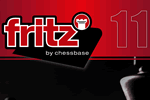


ChessBase 17 - Mega package - Edition 2024
It is the program of choice for anyone who loves the game and wants to know more about it. Start your personal success story with ChessBase and enjoy the game even more.
I've remarked to chessplaying friends that the Magic Eye isn't "magic" at all, that it works by accepted scientific principles (I've often expressed surprise that no one has ever sued the manufacturers of Magic Markers on the same grounds). I'll go a step further and tell you that the "Magic" Eye is technology, plain and simple -- it's obviously a robotic arm:

The purpose of this robotic arm is to show you in a graphic manner the variation which the engine currently thinks is best. The Magic Eye will swing back and forth over the 3D chessboard to show you a short (usually three to four plies [half-moves]) move sequence to illustrate what the chess engine has calculated as the best course of play for both sides.
There are three main components to the Magic Eye display; let's consider them one at a time.
The first is the inset view. This inset (a picture within a picture) literally centers on the piece the engine is considering moving. For example, consider the following illustration:

The chess engine is considering the move ...dxc6, so the inset display is centered on the Black d-pawn. Think of this display as a video inset, showing what the lens (mounted on the ball of the Magic Eye's swing arm) is photographing.
Note the presence of two buttons below this inset display. These buttons allow you to zoom this inset view in ("+") and out ("-").
A second component to Fritz' Magic Eye is a pair of laser beams:

One of the beams is colored red, the other is green. The red laser beam illuminates the piece the engine is considering moving (in this case it's the Black g-pawn; see the inset view, previously discussed). The green beam shows the destination square of the piece illuminated by the red laser; in this case it's illuminating the g6-square. In short, the red beam shows the starting square of the move while the green beam shows the destination square; together they display a complete move. In the illustration above, the move being considered is ...g7-g6.
As mentioned previously, the Eye will often display a short sequence of moves (usually no nore than two full moves [four plies] for the players). The Eye will also usually pause after displaying the last move of the variation before cycling back to the first move again; if you get confused, you can refer to the Engine analysis pane to see the variation displayed in standard chess notation.
The Magic Eye's third component is the lens located on the robotic arm. The arm supports a ball which contains the lasers and the camera lens. The lens not only provides the "inset" view for this display, but also gives us an indication of which side is ahead in the current position based on the chess engine's calculated variation: the lens changes color depending on the evaluation of the position at the end of the proposed variation. You'll note that in the above illustration the lens is colored green; this means that the moving side (in this case Black) will be ahead at the end of the engine's calculated variation. Here's a list of the colors and what they signify:
Please note, however, that this color coding will not be in effect while reviewing a database game with the chess engine running in "Infinite analysis" mode. The blue color will still appear in the lens for even positions, but red will no longer be an option -- the lens will appear green when one player has an advantage without regard for which player holds that edge. The standard color coding (listed above) will apply only to games in progress played against the chess engine.
I've received a few e-mails from players who find the arm distracting and wish to move or remove it. You can change the angle of the 3D chessboard by using the trakball at the lower lefthand corner of the 3D display:

You can spin the angle of the board by clicking on the trakball and holding down the mouse button, then moving the mouse to change the board's angle around a (invisible) center point. You can also use the arrows around the trakball to move the board laterally (i.e. change the center point itself).
A second possibility is to use the optional 2D board display as an "analysis" board if the Magic Eye's arm movement is too distracting or sometimes obscures part of the board. Go to the Window menu in Fritz, select "Panes", and then "Control board 2D" from the submenu. You'll see a new pane appear which will contain a 2D chessboard displaying the current board position:

Note that this 2D view doesn't replace the 3D board; it's displayed in addition to the 3D view.
As a final, most drastic, option, you can remove the Magic Eye completely. Click the "Settings" button (located below the trakball display; go back two illustrations for a reference), then the "General" option to get the following display:

In the righthand portion of this display, among the various display options, you'll see "Magic Eye" with a box beside it. You can check and uncheck this box to toggle the Magic Eye on and off; remember to click "Apply" and "OK" to actually effect the change.
Until next week, have fun!
You can e-mail me with your comments on ChessBase Workshop. All responses will be read, and sending an e-mail to this address grants us permission to use it in a future column. No tech support questions, please.